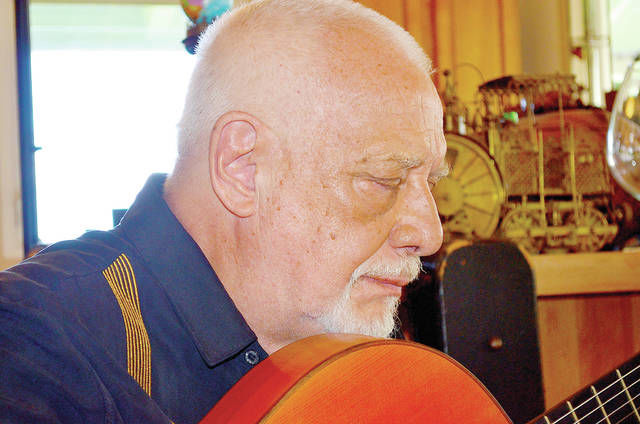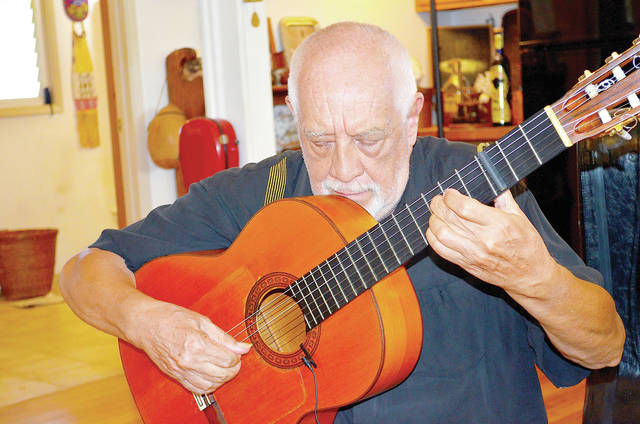Talk Story with Gilles Larrain
Gilles Larrain has lived a rare life.
A world-renowned photographer and artist, the 69-year-old has collaborated with some of the world’s biggest musicians and artists, such as Sting, John Lennon and Yoko Ono, Miles Davis and Billy Joel.
For a man who was behind the lens of a camera, he spent time under the spotlight throughout his career, spanning over five decades. Larrain claims he never worked a day in his life, or had a boss. His independent flavor for photography earned him great success, but not in terms of monetary compensation.
A Frenchman, Larrain was born in Vietnam. His mother was French-Vietnamese and his father was a Chilean diplomat living in Vietnam.
Larrain didn’t care for money and still doesn’t. He lives for the thrill and experience of life. Larrain strives to capture the landscape of the soul.
He has a knack for flamenco guitar, which he most recently played with Chamber Music Kauai. He calls playing flamenco guitar a burning passion that started decades ago.
On the lanai of his home in Kapaa that he shares with his wife, Louda — a decorated designer and artist — Larrain sat down with TGI and discussed his career, lessons learned and shared stories of the past.
You lived in so many different places, but how did you end up in Kauai?
My life is a series of jumps. From Vietnam to Chile, to Buenos Aires in Argentina where I studied, to studying architecture in Paris, I spent a lot of time in Mexico at one point because I like the architecture there and the history also, and New York where I had my studio in SoHo in a building that I bought. It was a mess that nobody wanted in 1973. It did not exist, it was a dump.
I worked for Club Med and did advertising for them. I went to Tahiti three times, Mexico many times, the Caribbean, Guadalupe, many other sites. And one day, they said “Listen, we have a village mostly for Japanese honeymooners, it’s not a very active village and we don’t like the location too much. Why don’t you go and look at it, take photos.” So I came here in ‘74 and spent 10 days on a helicopter, looking at every nooks and crannies if the island. And I said wow, what a beautiful island. I’m going to move here one day. And 44 years later, here we are. That’s a story.
When I told Louda, my Russian lady, a tough lady too, that we were going to move here, she said “What? What’s Kauai?” After New York and Paris, she’s a superstar designer, she’s big time in France. And coming to Kauai was a letdown in a way, but here we’re doing more creative projects at a different level. We’re doing a project with vegetation and flowers, no fabric.
After 45 years in Manhattan, I did what I wanted to do.
What was it like working with such amazing artists like Miles Davis?
Miles came to my studio in New York for a photo shoot and when we met, he raised his hand and said “Five minutes. That’s all I’ve got for you man.” So I figured he said five minutes because it was really hot outside, so I offered Miles water and some tapas.
We sat down and ate and drank water and five minutes turned into 10, which turned into 20, which turned into 30. Eventually, we talked about music.
He asked me about guitar and I told him I play flamenco guitar and Miles said “really? Go get your guitar. “And I said, “go get your trumpet.” Then we jammed in my studio for five hours.
What was it like working with John Lennon?
I never worked with John. I spent two days with them. You can see how relaxed they were in the photos. It wasn’t work.
He’s a bad cook. He’s English, I’m sorry but he burnt the eggs. I said “John, you’re a great musician and I love your work but not as a cook.” So I told him to give me 15 minutes and I went to get some eggs, maple syrup and Canadian bacon. I cooked for him and Yoko Ono.
Is it kind of surreal looking back at all the people you’ve met during your life?
There was a time when great people were alive and communicating. I’ve had very good friends who have died. The times are very boring now. Look at what’s happening with the power system right now. To go back to those times, in my dreams, it’s like a vacation.
I taught photography to young people and old people in New York. I had a man who was 83 years old who was an Auschwitz survivor and he wanted to learn portrait photography in my Intimate Portrait class for the ICP (International Center of Photography). And teaching there was a great experience for me. I really enjoyed it.
But this man was a survivor, he had numbers (on his forearm) and the youngest student in the class was Japanese, 17 years old. And they sat next to each other. The man who survived had tough times. He wanted to do a book on the last few survivors of the camps, so he wanted to learn how to take portraits. And he would come to me with his portraits and I told him to get to the landscape of the soul, not the graphic thing.
To answer your question, the times are very different now. Totally different.
If I (forget) what I’ve learned from the past, I’ll be very sad. You don’t have that yet. But those times were fantastic. It was not about money, it was not about the (expletive) dollar. I’ve never had a boss, I’ve always been independent. My function is to transmit my passion, that’s what I want to do to get people to have curious points of view that they don’t have automatically because an education won’t give that to you, it’s only through personal experience.
You take vacations in your memories. What’s one memory that stands out to you?
I have a memory that has nothing to do with my career. When I was about 8 years old in the south of France, my father and I went to see (Pablo) Picasso. I saw my father and Picasso walk into the water, similar bodies, and that image, I can see it now. It was my first photograph that I ever took. And it wasn’t with a camera, it was with my mind.
My father was a diplomat from Chile and was a painter, so there was a friendship like that.
So even as a kid, you were exposed to these types of people?
Yes, I was very, very blessed. I’ve had a rare life. A fantastic life, there’s a lot of joy inside of me. The luck of the Irish? I think I got it.
I’ve looked into your “Twins” series. I understand that you like to have your models in clothes and in the nude for photographs because it shows who they really are. Why is that?
It’s portraits of people. A single person or a group of people, friends or families in the same positions, dressed and naked. And I put both pictures together. You become your own twin. You are your own twin.
It’s the reality of who you are. You can camouflage yourself socially with the way you dress, those sorts of things. But a real portrait is who you are: Your limitations, your effects, your beauty, your grace, your landscape and the soul comes out of it.
My “Twins” series, which is a project I’ve been working on for a very long time, when a person is exposed, there is a reality that is much more powerful. The portrait is much more powerful. The person is willing to surrender, to accept the reality of who they are as they are. It’s a private moment.
You said it’s important for an artist to find their own voice, not to imitate someone else’s work. Why is that?
About 10 percent of my students were interesting. Thirty percent curious enough to maybe eventually get interesting, and then the rest were just trying to have a job, to make money through photography. And one of my students asked me, “How do I become successful in photography?” But the idea of money making is a thing. And when I was doing photography, it was through film. You could (expletive) very easily. And it wasn’t cheap. So you really fine-tune your individual juices to find your technique, a good technique.
So one day, this class came to the studio during the summer. I wanted no more than 12 students, I cannot teach 100 students. I asked them to write why and what they want to do, who they are and write about themselves so I can get to know them and help them get better. So this very arrogant, good-looking guy, very wealthy parents, comes with a huge leather portfolio with 16-by-20 silver prints, expensive prints, and he’s very proud because everyone comes around to his table and is very impressed.
He was very cocky, he thought he was the cat’s meow. I opened the pages and he asked me what I thought of it. And I said, well, these are very good prints. These are very nice, you didn’t make that, did you? And he said, no I had them printed. I knew he didn’t, he’s too young to have that craft. And they were copies of other photographers. I said, “This is not your work, this has nothing to do with you,” and I was really hard on him. I wasn’t gentle. I said that “I don’t think you’re interested in photography, I think you’re interested in success. And success might never come. Just look at Van Gogh, after his death success came.” And the guy left. I told him to get a refund and not take my class.
A year later, he reapplied and brought a small portfolio, very simplistic photos. But they were his photos. And I told him this was a good direction. You tell the truth to people; be honest; be strong.



